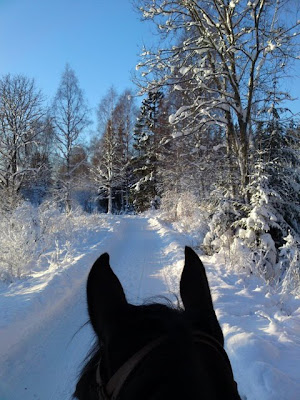
I would like to continue this discussion guys, thanks for participating!
Today’s question:
Do we have different character traits depending on what horse rase we are looking at?
Compare a thoroughbred with a pony.
Are there differences?
How much comes from handling, and how much comes from the breed?
Some pony breeds (Shetland, New Forest and the Swedish Gotlandruss being three examples) have roamed about in the wild, and have had to mend for themselves up to rather recently.
They are often both very food motivated and easily kept, as scarcity of food has been a strong selector in survival.
They are smart - as in testing things out.
If you have an escape artist in the yard, who would that be?
The smart and the sturdy ones survived. The others did not.
Ponies can be challenging to handle.
In my experience, they often test people out, and are very good at it too.
Let me give you two bright examples:
He is one of the riding school horses at the stable.
I suspect his owner gave him to the riding school because she found him difficult to handle.
What breed he is I do not know, but that there is some native pony of some sort in the mix I do not doubt when looking at him.
What breed he is I do not know, but that there is some native pony of some sort in the mix I do not doubt when looking at him.
Now, Maigutten won’t take a “No” for a No unless he has tested it out.
Guess who's got an extra chain on the door to his box/stall?
In spite of this, Maigutten often escapes.
He is a good dressage pony, and a very good jumper. With an experienced rider.
And for the rest?....He reads the rider in exactly 15 sec, and then either refuses to go, or starts doing funny exercises.
The entrance to the arena has to be closed to keep him in.

Is he a butthead?
Yes, definitely. But a smart and talented butthead.
My other example is the Shetlands pony May-Lis, now diseased, but used for pony riding in the riding school 15 years ago.
Yes, definitely. But a smart and talented butthead.
If the parents that were leading the child were used to horses, she was good as gold.
If the parents were not used to horses (quick assertion) she snapped at them, which made the parent let go of the rein.
Then she ran over to the nearest turf of grass, and turned her butt to the approaching parent and kicked loose at them when they came close enough.
Terrified child screaming, of course.
These are two horror examples, but I am sure that you guys can find similar (but perhaps less extreme) examples, at least of riding school horses that are used to quickly assess people and adjust their behavior accordingly.
My daughter's first pony was a cross Shetlandspony-Gotlandsruss, Felix.
I could tell you some stories about him too.
But he behaved *most* of the time, and was much loved.
All horses differ between people, but I do believe ponies make more out of it than other breeds.
Some people blame it on the fact that they are mostly handled by children.
Perhaps.
To a degree.
But is that the only explanation?
Another example: The Norwegian Fjord.I would say that what we have here is a Pony In Disguise.
I am sure that anyone that has had anything to do with a Fjord will agree with me when I say that they are wilful, sturdy, food loving and smart. I have never seen a skinny Fjord.
And they walk all over you if you let them.
Again, tough conditions and survival of the fittest.
But they are normally not handled by children, so I'd say we are speaking genetics here.
In my opinion you will find more "personalities" with native breeds than you will find in Warmbloods (or thoroughbreds) where many of the survival instincts are bred away.
But they might have other issues.
Our neighbour who runs the yard is a racehorse trainer, so we have thoroughbreds in the stable too.
My husband has had many of them up through the years as he litterally was bred into the sport. Below you see Fair Flair.

Have you seen the panic button on a Thoroughbred?
I hope you haven't, because it is not funny.
They just lock out the world and RUN.
A couple of years ago one of them (not one of ours, TG) got scared and galloped full speed (with rider) along a road for 9 km (5.6 miles), and litterally run its hoof off. Box rest for half a year. Unfortunately never recovered after that either.
The young rider got out of it unharmed, but that was only luck.
I have never seen that happen with a pony.

So what do you think?
Does breed count?
Can we say that a breed has certain traits?
And if so, in what way?
(and thanks to my daughter for the first and last picture)









 Had two lovely trail rides the weekend before last, in spite of the cold.
Had two lovely trail rides the weekend before last, in spite of the cold.










































